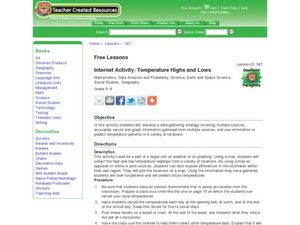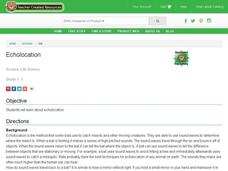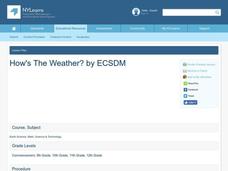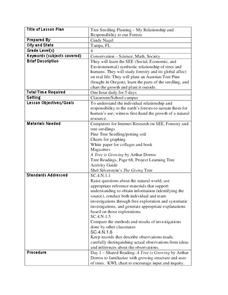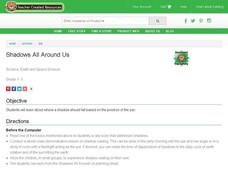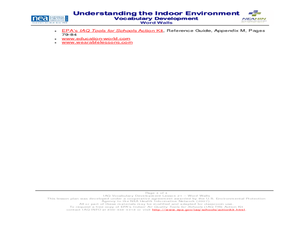Curated OER
What Shape is the Moon Tonight?
Students understand that the moon appears differently throughout the month. In this phases of the moon lesson, students observe and record the phases of the moon.
Curated OER
Sky Watchers: Ancient Astronomers
Students close their eyes and picture the sky. They are asked to brainstorm things they may see in the course of a night and day, such as the movement of the sun, moon, and stars. Students work in groups to coduct their research. They...
Curated OER
Wind
Students conduct an experiment. In this wind measurement lesson, students learn about instruments that measure the wind and then make a weather vane. Students record wind speed over a few days.
Curated OER
Temperature High and Lows
Students gather high and low temperature readings through email. For this temperature graphing lesson, students use a spreadsheet to input data for a graph. students interpret the graphs to compare and contrast the data from different...
Curated OER
American Frontiers
High schoolers study the settlement of the American frontier through literature. In this literature lesson, students read and discuss works by James Fenimore Cooper, Bret Harte, Mark Twain, Willa Cather, and Hamlin Garland. High...
Curated OER
Echolocation
Students explore echolocation. In this bats science lesson, students compare sunlight reflecting off a mirror to sound waves hitting a bat's ears. Students complete a worksheet about bats.
Curated OER
African Mask
Students make masks. In this African art lesson, students review background information about African art and the use of masks. Students use geometric shapes and other designs to create their masks.
Curated OER
African Mask
Students research the importance of masks to the African culture. In this African mask lesson, students design original masks using a variety of materials. Students use the template provided to create their masks.
Curated OER
How's the Weather?
Students explore earth science by researching the Internet. In this weather pattern activity, students utilize the website weather.com to analyze the weather in different geographic locations. Students view charts and graphs based on...
Curated OER
Junk Sort
Students analyze objects by one or more attributes. In this sorting lesson, students use manipulatives and string or yarn to create a sorting game. Students read books and items from the classroom to sort.
Curated OER
Tree Seedling Planting- My Relationship and Responsibility to our Forests
In this trees lesson, 4th graders read the book, A Tree is Growing and complete a KWL chart on how trees grow and how they are used. Students research the symbiotic relationship of humans and trees, create tree collages, plant a...
Curated OER
The Environment and You
First graders examine the human environmental impact and discover ways to lessen effects. They create a pollution damage flow chart and write down what they think Mother Earth might say. They create inventions from recyclable materials.
Curated OER
Consumer Confusion: Wants versus Needs and Gandhi's Wisdom
Fourth graders create graphs to illustrate consumer consumption throughout the world. In this consumer lesson plan, 4th graders also discuss wants and needs around the world, and consider Gandhi's opinion on material possessions as they...
Curated OER
Astronomy
Students explore the rotation of the Earth and observe the shapes of constellations. After discussing how the Earth moves. volunteers use a flashlight and globe to model the movement of the sun-Earth system. Using Digitalis technology,...
Curated OER
Constellations
Students explore the major constellations. After reviewing the Earth's basic motions and their significance, students discuss the moon's orbit and revolutions. Using a Digitarium Alpha portable planetarium projector, they observe at...
Curated OER
Shadows All Around Us
Young scholars create shadows. In this shadow casting lesson, students read books about shadows, view a demonstration on shadow casting and then practice shadow casting on their own. Young scholars cast a shadow using the position of the...
Curated OER
Retrograde Motion of Mars
Learners investigate the motion of Mars. In this space science lesson, students use transparencies to trace the path of Mars through constellations. Learners discuss the characteristics of the planet.
Curated OER
Changing Weather: Comparing Climate from Voyageur Times to Today
Fifth graders compare climates. In this weather lesson, 5th graders observe and record weather observations and discuss the impact of weather on people. Students also discuss the concept of global warming and determine how weather...
Curated OER
Directional Terms
Pupils identify and demonstrate various locational terms, and examine how a globe is a model of Earth. They repeat words and movements for various finger plays to demonstrate locational terms, play directional words games, and sing a...
Curated OER
How to Work With Time Zones
Students solve time zone problems. In this time zone lesson, students view a time zone map and learn about the 24 time zones. Students are given a worksheet where they compute the time in different areas.
Curated OER
Hello, Anybody Out There?
Learners understand that people believe there may be life in other solar systems. In this communication with other solar systems instructional activity, students analyze our planet and write things they want to communicate to other solar...
Curated OER
Walden the Ballad of Thoreau
Learners role play to become familiar with the life of Thoreau. In this Thoreau lesson, students view a video of the Walden play about Thoreau. Learners perform and promote the play as a school event.
Curated OER
Understanding the Indoor Environment: Word Walls
Students study vocabulary words about indoor air quality. In this indoor environment lesson, students create a word wall with vocabulary words about indoor air quality and pollutants.
Curated OER
Forces and Newton's Laws Unit
Students participate in lessons on Forces and Newton's Laws by selecting activities and assignments to complete in a Layer Unit. Students select assignments and activities in the C Level, B Level, and A Level.





